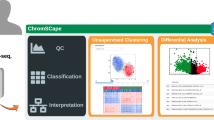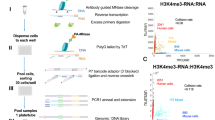Abstract
Methods for quantifying gene expression1 and chromatin accessibility2 in single cells are well established, but single-cell analysis of chromatin regions with specific histone modifications has been technically challenging. In this study, we adapted the CUT&Tag method3 to scalable nanowell and droplet-based single-cell platforms to profile chromatin landscapes in single cells (scCUT&Tag) from complex tissues and during the differentiation of human embryonic stem cells. We focused on profiling polycomb group (PcG) silenced regions marked by histone H3 Lys27 trimethylation (H3K27me3) in single cells as an orthogonal approach to chromatin accessibility for identifying cell states. We show that scCUT&Tag profiling of H3K27me3 distinguishes cell types in human blood and allows the generation of cell-type-specific PcG landscapes from heterogeneous tissues. Furthermore, we used scCUT&Tag to profile H3K27me3 in a patient with a brain tumor before and after treatment, identifying cell types in the tumor microenvironment and heterogeneity in PcG activity in the primary sample and after treatment.
This is a preview of subscription content, access via your institution
Access options
Access Nature and 54 other Nature Portfolio journals
Get Nature+, our best-value online-access subscription
$29.99 / 30 days
cancel any time
Subscribe to this journal
Receive 12 print issues and online access
$209.00 per year
only $17.42 per issue
Buy this article
- Purchase on Springer Link
- Instant access to full article PDF
Prices may be subject to local taxes which are calculated during checkout



Similar content being viewed by others
Data availability
Sequencing data are deposited in the Gene Expression Omnibus with accession code GSE157910. There are no restrictions on data use.
Code availability
Code used in this study can be found on GitHub at https://github.com/Henikoff/scCUT-Tag.
References
Tanay, A. & Regev, A. Scaling single-cell genomics from phenomenology to mechanism. Nature 541, 331–338 (2017).
Klemm, S. L., Shipony, Z. & Greenleaf, W. J. Chromatin accessibility and the regulatory epigenome. Nat. Rev. Genet. 20, 207–220 (2019).
Kaya-Okur, H. S. et al. CUT&Tag for efficient epigenomic profiling of small samples and single cells. Nat. Commun. 10, 1930 (2019).
Lee, T. I. et al. Control of developmental regulators by polycomb in human embryonic stem cells. Cell 125, 301–313 (2006).
Laugesen, A. & Helin, K. Chromatin repressive complexes in stem cells, development, and cancer. Cell Stem Cell 14, 735–751 (2014).
Sparmann, A. & Van Lohuizen, M. Polycomb silencers control cell fate, development and cancer. Nat. Rev. Cancer 6, 846–856 (2006).
Granja, J. M. et al. ArchR is a scalable software package for integrative single-cell chromatin accessibility analysis. Nat. Genet. 53, 403–411 (2021).
Hawkins, R. D. et al. Distinct epigenomic landscapes of pluripotent and lineage-committed human cells. Cell Stem Cell 6, 479–491 (2010).
Chu, L.-F. et al. Single-cell RNA-seq reveals novel regulators of human embryonic stem cell differentiation to definitive endoderm. Genome Biol. 17, 173 (2016).
Granja, J. M. et al. Single-cell multiomic analysis identifies regulatory programs in mixed-phenotype acute leukemia. Nat. Biotechnol. 37, 1458–1465 (2019).
Heaton, H. et al. Souporcell: robust clustering of single-cell RNA-seq data by genotype without reference genotypes. Nat. Methods 17, 615–620 (2020).
Bhaduri, A. et al. Outer radial glia-like cancer stem cells contribute to heterogeneity of glioblastoma. Cell Stem Cell 26, 48–63.e46 (2020).
Patel, A. P. et al. Single-cell RNA-seq highlights intratumoral heterogeneity in primary glioblastoma. Science 344, 1396–1401 (2014).
Couturier, C. P. et al. Single-cell RNA-seq reveals that glioblastoma recapitulates a normal neurodevelopmental hierarchy. Nat. Commun. 11, 3406 (2020).
Wang, Q. et al. Tumor evolution of glioma-intrinsic gene expression subtypes associates with immunological changes in the microenvironment. Cancer Cell 32, 42–56 (2017).
Liau, B. B. et al. Adaptive chromatin remodeling drives glioblastoma stem cell plasticity and drug tolerance. Cell Stem Cell 20, 233–246 (2016).
Janssens, D. H. et al. Automated in situ chromatin profiling efficiently resolves cell types and gene regulatory programs. Epigenetics Chromatin 11, 74 (2018).
ENCODE Project Consortium. An integrated encyclopedia of DNA elements in the human genome. Nature 489, 57–74 (2012).
Llorens-Bobadilla, E. et al. Single-cell transcriptomics reveals a population of dormant neural stem cells that become activated upon brain injury. Cell Stem Cell 17, 329–340 (2015).
Segerman, A. et al. Clonal variation in drug and radiation response among glioma-initiating cells is linked to proneural–mesenchymal transition. Cell Rep. 17, 2994–3009 (2016).
Meissner, A. et al. Genome-scale DNA methylation maps of pluripotent and differentiated cells. Nature 454, 766–770 (2008).
Rheinbay, E. et al. An aberrant transcription factor network essential for Wnt signaling and stem cell maintenance in glioblastoma. Cell Rep. 3, 1567–1579 (2013).
O’Neill, K. M. et al. Depletion of DNMT1 in differentiated human cells highlights key classes of sensitive genes and an interplay with polycomb repression. Epigenetics Chromatin 11, 12 (2018).
Meers, M. P., Janssens, D. H. & Henikoff, S. Pioneer factor–nucleosome binding events during differentiation are motif encoded. Mol. Cell 75, 562–575 (2019).
Stuart, T. et al. Comprehensive integration of single-cell data. Cell 177, 1888–1902 (2019).
Becht, E. et al. Dimensionality reduction for visualizing single-cell data using UMAP. Nat. Biotechnol. https://doi.org/10.1038/nbt.4314 (2018).
Schep, A. N., Wu, B., Buenrostro, J. D. & Greenleaf, W. J. chromVAR: inferring transcription-factor-associated accessibility from single-cell epigenomic data. Nat. Methods 14, 975–978 (2017).
Sergushichev, A. A. An algorithm for fast preranked gene set enrichment analysis using cumulative statistic calculation. Preprint at bioRxiv https://doi.org/10.1101/060012 (2016).
Liberzon, A. et al. Molecular signatures database (MSigDB) 3.0. Bioinformatics 27, 1739–1740 (2011).
Acknowledgements
We thank E. Holland and members of the Holland lab for providing shared space for experimental work, the Fred Hutchinson Genomics Shared Resource for DNA sequencing and microfluidics services and BioRender for helping create figures. We thank T. Bryson, C. Codomo, J. Henikoff, M. Meers, D. Janssens, M. Setty, J. Thakur and other members of the Henikoff lab for helpful suggestions and discussions. We also thank the Koeplin Family Foundation and the Nancy and Buster Alvord Endowment, as well as A. Schantz for administrative support and L. Keene, A. Keen and K. Kern for technical support with autopsy specimen collection. This work was supported by the Howard Hughes Medical Institute (to S.H.); grants R01 HG010492 (to S.H.), R01 GM108699 (to K.A.) and K08 CA245037 (to P.J.C.) from the National Institutes of Health; an HCA Seed Network grant from the Chan-Zuckerberg Initiative (to S.H., A.P.P, S.N.F, R.G., K.A. and Y.Z.); a Burroughs Wellcome Career Award for Medical Scientists (to A.P.P.); and an American Cancer Society Mentored Scholar Award (to S.N.F). The Scientific Computing Infrastructure at the Fred Hutchinson Cancer Research Center is funded by ORIP grant S10OD028685.
Author information
Authors and Affiliations
Contributions
S.J.W., S.N.F., A.B.M., H.K-O., A.H.F., S.N.E., and J.F.S. processed samples and performed experiments. S.J.W., S.N.F., Y.Z., R.G. and A.P.P. performed and/or provided input on data processing and analysis. K.C., P.J.C. and C.D.K. provided access to tissue samples and assisted with processing. S.J.W., S.N.F., K.A., S.H. and A.P.P. wrote the manuscript with input from all authors.
Corresponding authors
Ethics declarations
Competing interests
S.N.F. has received research support from Lyell Immunopharma. R.G. has received consulting income from Juno Therapeutics, Takeda, INFOTECHSoft, Celgene and Merck; has received research support from Janssen Pharmaceuticals and Juno Therapeutics; and declares ownership in CellSpace Biosciences. H.S.K. and S.H. have filed patent applications related to this work. A.P.P. declares ownership in Sygnomics.
Additional information
Publisher’s note Springer Nature remains neutral with regard to jurisdictional claims in published maps and institutional affiliations.
Supplementary information
Supplementary Information
Supplementary Figs. 1–8 and Table 1.
Rights and permissions
About this article
Cite this article
Wu, S.J., Furlan, S.N., Mihalas, A.B. et al. Single-cell CUT&Tag analysis of chromatin modifications in differentiation and tumor progression. Nat Biotechnol 39, 819–824 (2021). https://doi.org/10.1038/s41587-021-00865-z
Received:
Accepted:
Published:
Issue Date:
DOI: https://doi.org/10.1038/s41587-021-00865-z
This article is cited by
-
Dictionary learning for integrative, multimodal and scalable single-cell analysis
Nature Biotechnology (2024)
-
Nano-CUT&Tag for multimodal chromatin profiling at single-cell resolution
Nature Protocols (2024)
-
Scalable single-cell profiling of chromatin modifications with sciCUT&Tag
Nature Protocols (2024)
-
Insights gained from single-cell analysis of chimeric antigen receptor T-cell immunotherapy in cancer
Military Medical Research (2023)
-
Single-cell sequencing technology applied to epigenetics for the study of tumor heterogeneity
Clinical Epigenetics (2023)



